Get the weekly SPARTANAT newsletter.
Your bonus: the free E-Book from SPARTANAT.
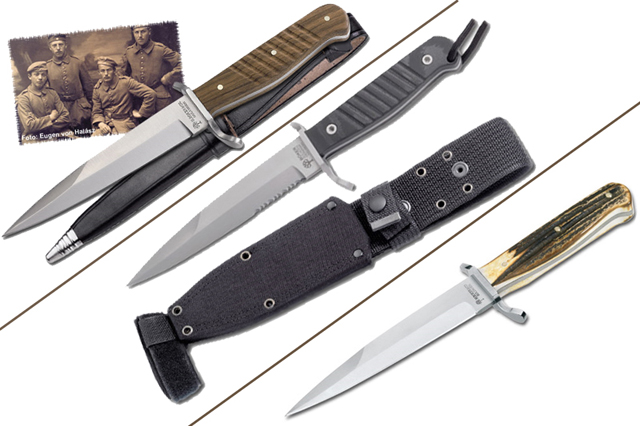
REVIEW: The German trench daggers
Trench knives emerged in the First World War because soldiers in trench warfare needed handy stabbing weapons for close combat. Since 1915, the blade produced by Böker has hardly changed, up to the modern trench knife 2000, it is a classic weapon with a 100-year tradition. SPARTANAT author Udo Lücken presents it.
In hardly any war were there such great upheavals in combat tactics and weapons development as in the Great War of 1914-1918. Until then, the armies of the opponents lined up in static formations and fired more or less targeted volleys at their enemies. The image of mobile warfare changed in the first years to the hitherto unknown trench warfare. Due to the stalemate of the evenly matched armies, the units were forced to dig in and conduct combat from fortified positions. Days of artillery barrages now swept the soldiers' trenches. From then on, the machine gun and the sniper dominated the battlefield. During the occasional, very costly assaults on the positions of the enemy, there were bitter close combat fights in the labyrinths of the trench positions, man against man, in a confined space. Initially fought with fixed bayonets, soldiers quickly realized how impractical their old uniforms, equipment, and weapons were for this type of combat. Improvised close combat weapons such as axes, short spades, clubs, and shortened bayonets were quickly produced in large numbers in field forges. But even these weapons were too unwieldy for the so-called "patrol thefts" or the "raids" in the crater landscape of no man's land. Many soldiers therefore brought hunting knives as "unissued service weapons" from their front leave or even had sturdy kitchen knives sent to them by the dozen from home. These knives served as weapons and tools in daily use.
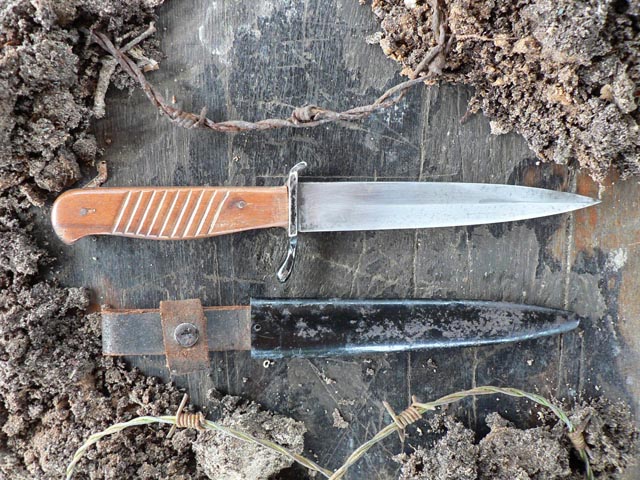 However, the demand for close combat weapons could not be met. Therefore, the traditional knife company H.Böker & Co from Solingen received an order in 1915 from the Army Ordnance Department in Berlin to produce a compact knife for the front-line troops. This dagger had to be inexpensive, produced in large quantities, and quickly. It had to be robust and functional and meet the requirements of the front. In the following years, approximately 90,000 pieces were produced and mainly issued to the newly established storm troops and assault pioneers. The trench knife quickly gained great popularity among the front-line soldiers. Some decorated their dagger with elaborate, personal engravings and even gave it a name. Even in photos from the war of 1939-1945, soldiers are depicted wearing a Böker trench knife on their belt.
However, the demand for close combat weapons could not be met. Therefore, the traditional knife company H.Böker & Co from Solingen received an order in 1915 from the Army Ordnance Department in Berlin to produce a compact knife for the front-line troops. This dagger had to be inexpensive, produced in large quantities, and quickly. It had to be robust and functional and meet the requirements of the front. In the following years, approximately 90,000 pieces were produced and mainly issued to the newly established storm troops and assault pioneers. The trench knife quickly gained great popularity among the front-line soldiers. Some decorated their dagger with elaborate, personal engravings and even gave it a name. Even in photos from the war of 1939-1945, soldiers are depicted wearing a Böker trench knife on their belt.
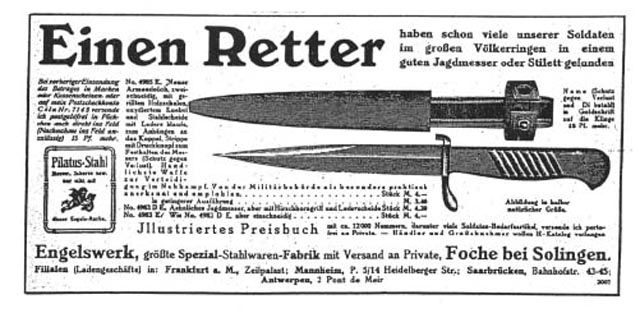 For the 90th anniversary and at the request of collectors, the company Böker/ Baumwerk launched a collection of 4 replicas and interpretations of this historically significant trench knife. The high demand arises, moving away from the US WWII and Vietnam knives, from an increasing awareness of one's own history of the 19th and 20th centuries. Like the original, the 165 g heavy replica is made of C-75 carbon steel. With its 14.4 cm long, very edge-retaining blade and a total length of 25.6 cm, it is optimally sized for its original purpose, close combat. The sturdy 3.5 mm thick blade is single-edged and tapers about 5 cm before the tip from both sides to the typical dagger shape. It penetrates several layers of fabric and leather without much resistance. Even sheet metal and wooden panels are not a problem. The handle made of fine-pored laminated wood is ergonomically shaped and fits well in the hand. Its grippy shape, as well as the 8 serrated cutouts, also enable secure handling with gloves and in rain or during matches. The massive stainless steel guard protects the fingers from cuts and almost automatically guides the hand into the optimal grip shape. The trench knife is delivered with a solid, dark leather sheath in which the blade is securely clamped. A snap fastener additionally secures the dagger against loss. The slim, tapering sheath ends with a metal tip that protects the dagger tip from damage. The large belt loop allows for carrying on any belt width.
For the 90th anniversary and at the request of collectors, the company Böker/ Baumwerk launched a collection of 4 replicas and interpretations of this historically significant trench knife. The high demand arises, moving away from the US WWII and Vietnam knives, from an increasing awareness of one's own history of the 19th and 20th centuries. Like the original, the 165 g heavy replica is made of C-75 carbon steel. With its 14.4 cm long, very edge-retaining blade and a total length of 25.6 cm, it is optimally sized for its original purpose, close combat. The sturdy 3.5 mm thick blade is single-edged and tapers about 5 cm before the tip from both sides to the typical dagger shape. It penetrates several layers of fabric and leather without much resistance. Even sheet metal and wooden panels are not a problem. The handle made of fine-pored laminated wood is ergonomically shaped and fits well in the hand. Its grippy shape, as well as the 8 serrated cutouts, also enable secure handling with gloves and in rain or during matches. The massive stainless steel guard protects the fingers from cuts and almost automatically guides the hand into the optimal grip shape. The trench knife is delivered with a solid, dark leather sheath in which the blade is securely clamped. A snap fastener additionally secures the dagger against loss. The slim, tapering sheath ends with a metal tip that protects the dagger tip from damage. The large belt loop allows for carrying on any belt width.
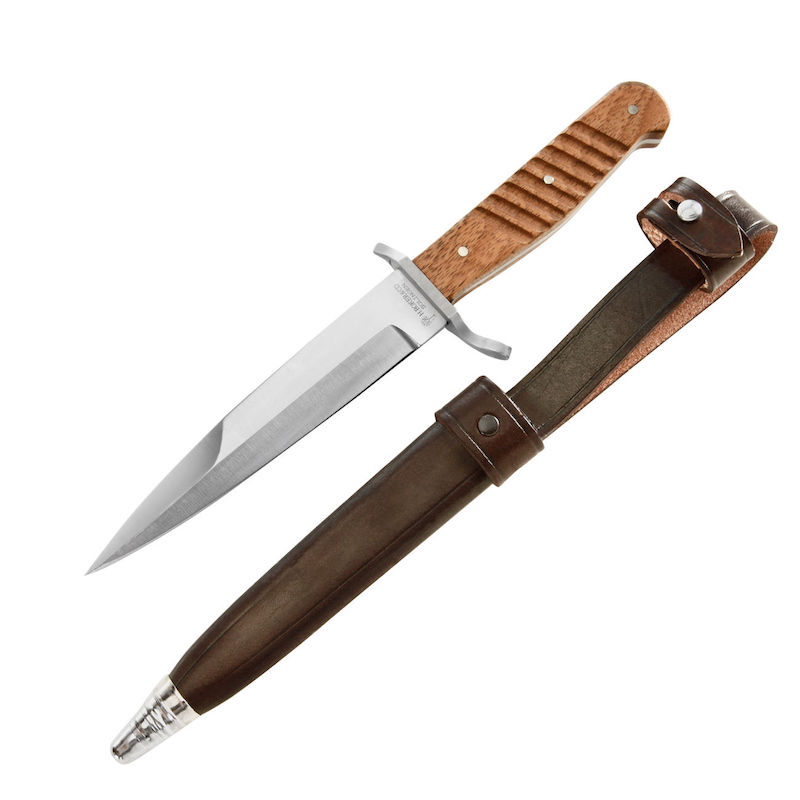 The hunting knife, which is also based on the trench knife, differs firstly by the exquisite handle scales made of stag horn. The material impresses with its colored grain and surface structure. It is so individual that each knife is unique in its appearance. Secondly, the leather sheath is equipped with an additional securing strap that allows for action even under difficult conditions, e.g. when tracking or in the tree stand.
The hunting knife, which is also based on the trench knife, differs firstly by the exquisite handle scales made of stag horn. The material impresses with its colored grain and surface structure. It is so individual that each knife is unique in its appearance. Secondly, the leather sheath is equipped with an additional securing strap that allows for action even under difficult conditions, e.g. when tracking or in the tree stand.
Both knives have the historical, original stamping on the ricasso and consecutive serial numbers.
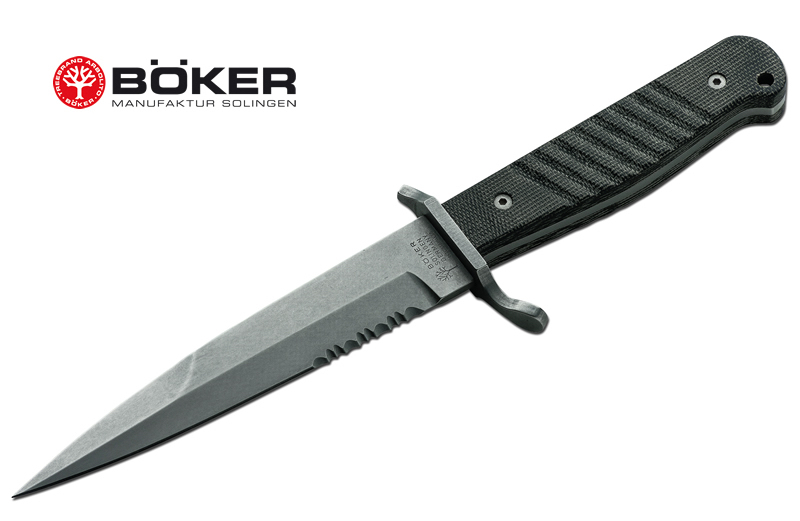 The modern Böker 2000 is a true all-purpose knife that clearly appeals to the Bundeswehr and police forces. In addition to its original purpose, close combat, it is also suitable as a lever and tool due to its stable shape. The partial, extremely sharp serrated edge effortlessly cuts through thick ropes, meat, bones, and sheets. But it also cuts bread and sausage. The rust-free 440-C blade received a matte, non-reflective appearance through sandblasting, emphasizing its suitability for use. The handle is made of dark, almost indestructible Micarta. It also has the typical crosswise grooves that ensure a good grip.
The modern Böker 2000 is a true all-purpose knife that clearly appeals to the Bundeswehr and police forces. In addition to its original purpose, close combat, it is also suitable as a lever and tool due to its stable shape. The partial, extremely sharp serrated edge effortlessly cuts through thick ropes, meat, bones, and sheets. But it also cuts bread and sausage. The rust-free 440-C blade received a matte, non-reflective appearance through sandblasting, emphasizing its suitability for use. The handle is made of dark, almost indestructible Micarta. It also has the typical crosswise grooves that ensure a good grip.
Particularly noteworthy is the well-thought-out, multifunctional Cordura sheath with its innovative belt attachment and leg fix. The strap loop is universally adjustable for any belt width by means of Velcro and snaps. The belt does not even have to be removed for this purpose. The additional fastening of the sheath on the thigh can be done individually with a Velcro band. An integrated rubber band ensures additional adhesion, preventing the knife from shaking while walking, running, climbing, etc. A "paracord" called lanyard secures the knife against loss during handling.
Like the original, the replicas are designed "for eternity." The trench knife is both a showpiece for the display case and made for the tough everyday use of a hunter, adventurer, or soldier.
SPARTANAT is the online magazine for Military News, Tactical Life, Gear & Reviews.
Send us your news: [email protected]
Ad
similar
Get the weekly SPARTANAT newsletter.
Your bonus: the free E-Book from SPARTANAT.


